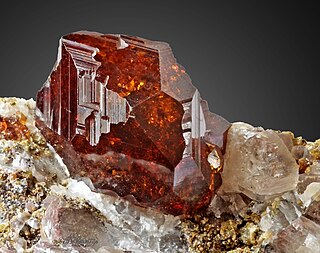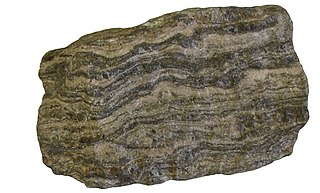
Aagaard Glacier, also known as Glaciar Alderete, is an 8-mile (13 km) long Antarctic glacier which lies close to the east of Gould Glacier and flows in a southerly direction into Mill Inlet, on the east coast of Graham Land. It was charted by the Falkland Islands Dependencies Survey (FIDS) and photographed from the air by the Ronne Antarctic Research Expedition during December 1947; it was named by the FIDS for Bjarne Aagaard, a Norwegian authority on Antarctic whaling and exploration.
The Intention Nunataks are a group of peaked nunataks between Solo Nunatak and the Forgotten Hills, at the southwestern margin of Evans Névé, Antarctica. They were named by the northern party of the New Zealand Geological Survey Antarctic Expedition, 1962–63, as the surveyor's intention to place a survey station here was thwarted by weather and other factors. The topographical feature lies situated on the Pennell Coast, a portion of Antarctica lying between Cape Williams and Cape Adare.
Cape Découverte or Cape Discovery is the point of rocks which marks the northwest extremity of the Curzon Islands along the Adélie Coast. It was discovered on January 21, 1840 by the French Antarctic Expedition, 1837–40, under Captain Jules Dumont d'Urville who gave the name "Cap de la Decouverte". It was the first rocky point of the coast seen by members of the expedition.

Wilson Glacier is a glacier 9 nautical miles (17 km) long, flowing northeast into Edward VIII Ice Shelf just south of Seaton Glacier. Photographed from ANARE aircraft in 1956. Named by Antarctic Names Committee of Australia (ANCA) for Flight Lieutenant H.O. Wilson, RAAF pilot at Mawson Station, 1959, who was killed in an aircraft accident shortly after his return to Australia.
Anderson Pyramid is a distinctive pyramidal peak, the southernmost member of the Bigler Nunataks, in the Usarp Mountains of Antarctica. It was named by the Advisory Committee on Antarctic Names for Staff Sergeant Robert J. Anderson, U. S. Army, non-commissioned officer in charge of the enlisted detachment of the helicopter group supporting the United States Geological Survey survey Topo East-West, 1962–63, which included the survey of this feature.
The Cape-Pigeon Rocks are twin rocky promontories on the western side of Watt Bay, 6 kilometres (3 nmi) south of Garnet Point. They were discovered by the Australasian Antarctic Expedition (1911–14) under Douglas Mawson, who gave the name because of the large Cape pigeon rookery here. The Advisory Committee on Antarctic Names has added a hyphen between the first and second words in the specific part of the name to reduce ambiguity and emphasize the generic term "Rocks."
Way Archipelago is a more than 120 small islands and rocks, of which the largest is Stillwell Island, distributed close off shore in the form of an arc. The archipelago extends from the vicinity of Cape Gray, at the east side of the entrance to Commonwealth Bay, to the vicinity of Garnet Point, at the west side of the entrance to Watt Bay. Discovered by the Australasian Antarctic Expedition (1911–14) under Douglas Mawson, who named the group for Sir Samuel Way, Chancellor of the University of Adelaide in 1911.

Widdowson Glacier is a glacier situated between Drummond and McCance Glaciers and flowing into Darbel Bay south of Sokol Point, on the west coast of Graham Land.

Swithinbank Glacier is a glacier on the west side of Hemimont Plateau flowing north to the southeast corner of Square Bay, in Graham Land. Mapped by Falkland Islands Dependencies Survey (FIDS) from surveys and air photos, 1946-59. Named by United Kingdom Antarctic Place-Names Committee (UK-APC) for Charles Swithinbank, British glaciologist, a participant in several British, New Zealand and American expeditions to Antarctica, 1949-62.
Mount Jiracek is a mountain, 2,430 metres (7,970 ft) high, rising at the west side of the head of Tinker Glacier, in the Southern Cross Mountains of Victoria Land, Antarctica. It was mapped by the United States Geological Survey from surveys and U.S. Navy air photos, 1960–64, and was named by the Advisory Committee on Antarctic Names for George R. Jiracek, a geophysicist at McMurdo Station in 1964–65.
Epidote Peak is a prominent rock peak just north of the mouth of Held Glacier, overlooking the west side of Shackleton Glacier in the Queen Maud Mountains of Antarctica. It was so named by the Texas Tech Shackleton Glacier Expedition, 1964–65, because of the abundance of the mineral epidote which gives the peak a spotted appearance.
Gipps Ice Rise is a roughly elliptical ice rise, 10 nautical miles (19 km) long and bounded by an ice cliff on all sides, lying at the edge of the Larsen Ice Shelf about 35 nautical miles (65 km) northeast of Hearst Island. The feature was discovered by William R. MacDonald of the United States Geological Survey (USGS), December 18, 1966, while on a photographic mapping mission of this area aboard a Super Constellation aircraft crewed by the U.S. Navy VXE-6 Squadron. The ice rise was first mapped from these photos by the USGS. The name was proposed by the UK Antarctic Place-Names Committee for Derek R. Gipps, a Senior Executive Officer with the British Antarctic Survey, 1961–73.
Mount McGhee is a mountain 4 nautical miles (7.4 km) south of Mount Smethurst in Enderby Land, Antarctica. It was plotted from air photos taken from Australian National Antarctic Research Expeditions aircraft in 1957 and was named by the Antarctic Names Committee of Australia for J. McGhee, a mechanic and driver at Wilkes Station in 1961.
Cape Markov is an ice cape on the east side of Amundsen Bay, situated 7 nautical miles (13 km) west of Mount Riiser-Larsen in Enderby Land, Antarctica. It was named by the Soviet Antarctic Expedition, 1961–62, for K.K. Markov, professor of geography at Moscow State University, and the author of a number of reports on Antarctica.
Cape Hoadley is a prominent rock coastal outcrop forming the west portal of the valley occupied by Scott Glacier in East Antarctica. It was discovered by the Western Base Party of the Australasian Antarctic Expedition under Mawson in November 1912, and named by him for C.A. Hoadley, a geologist with the party.

Holmes Glacier is a broad glacier debouching into the western part of Porpoise Bay about 10 nautical miles (20 km) south of Cape Spieden. It was delineated from aerial photographs taken by U.S. Navy Operation Highjump (1946–47), and was named by the Advisory Committee on Antarctic Names after Dr. Silas Holmes, Assistant Surgeon on the brig Porpoise during the United States Exploring Expedition (1838–42) under Lieutenant Charles Wilkes.
Kampekalven Mountain is a mountain, 2,200 metres (7,200 ft) high, forming the northeast end of the Filchner Mountains in Queen Maud Land, Antarctica. It was photographed from the air by the Third German Antarctic Expedition (1938–39), was mapped from surveys and air photos by the Sixth Norwegian Antarctic Expedition (1956–60) and named Kampekalven.
Mount Keyser is a mountain 3 nautical miles (6 km) east of Mount Ryder, in the eastern part of the Tula Mountains in Enderby Land, Antarctica. It was plotted from air photos taken from Australian National Antarctic Research Expeditions aircraft in 1957, and was named by the Antarctic Names Committee of Australia for D.O. Keyser, a radio officer at Mawson Station in 1961.
Landmark Point is a rocky point lying 1 kilometre (0.5 nmi) southeast of Safety Island, on the coast of Mac. Robertson Land, Antarctica. It was mapped from Australian National Antarctic Research Expeditions surveys and air photos, 1956–66, and was so named by the Antarctic Names Committee of Australia because it is almost due south from Auster Rookery and affords an excellent landmark if approaching the rookery along the coast from Mawson Station.
Launch Rock is a submerged rock lying southwest of the Glover Rocks, off the south end of Adelaide Island, Antarctica. It was named by the UK Antarctic Place-Names Committee to commemorate the unnamed launch from RRS John Biscoe that was used by the Hydrographic Survey Unit which charted this area in 1963.









